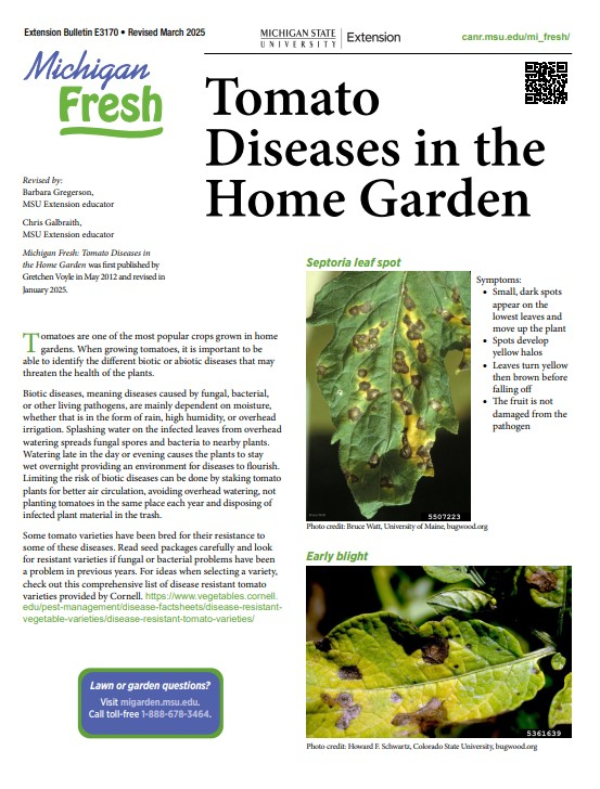
Bulletin E3170
Michigan Fresh: Tomato Diseases in the Home Garden
DOWNLOAD
June 5, 2025 - Barbara Gregerson and Chris Galbraith, Michigan State University Extension
Tomatoes are one of the most popular crops grown in home gardens. When growing tomatoes, it is important to be able to identify the different biotic or abiotic diseases that may threaten the health of the plants. Biotic diseases, meaning diseases caused by fungal, bacterial, or other living pathogens, are mainly dependent on moisture, whether that is in the form of rain, high humidity, or overhead irrigation. Splashing water on the infected leaves from overhead watering spreads fungal spores and bacteria to nearby plants. Watering late in the day or evening causes the plants to stay wet overnight providing an environment for diseases to flourish. Limiting the risk of biotic diseases can be done by staking tomato plants for better air circulation, avoiding overhead watering, not planting tomatoes in the same place each year and disposing of infected plant material in the trash. Some tomato varieties have been bred for their resistance to some of these diseases. Read seed packages carefully and look for resistant varieties if fungal or bacterial problems have been a problem in previous years. For ideas when selecting a variety, check out this comprehensive list of disease resistant tomato varieties provided by Cornell.
Septoria leaf spot
Symptoms:
• Small, dark spots appear on the lowest leaves and move up the plant
• Spots develop yellow halos
• Leaves turn yellow then brown before falling off
• The fruit is not damaged from the pathogen
Early blight
Symptoms:
• Dark spots with a bullseye appearance appear on older leaves
• Leaves turn yellow and fall off
• Stems may have dark lesions
• Stem end of fruit may have dark brown leathery spots with concentric rings
• Infected fruit falls off
Late blight

Symptoms:
- Pale green to brown spots with a purplish cast on the leaves
- Spots enlarge, turn brown to purple-black
- Yellow or green halos can encircle the spots
- Leaves shrivel and die
- Lesions on the stems can grow rapidly and kill the stem
- Rotting begins near the stem end of the fruit
- Grey-green to brown irregularly shaped spots appear and rapidly grow on fruit
Note: Early blight and late blight, despite the name, occur at any
time of the growing season if the right conditions are present.
Anthracnose
Symptoms:
- Leavers are not damaged
- Small, slightly depressed, water-soaked spots appear on fruit
- Spots enlarge, become sunken, and develop concentric rings
- Tiny black spots may appear in the lesions
- Large rotting areas may appear
Bacterial Spot
Symptoms:
- Small, dark, water-soaked spots on leaves
- Yellowing leaves
- Leaf loss
- Fruit develops small, dark blisters that can look like scabs
Bacterial Speck
Symptoms:
- Small, black spots on underside of leaves
- Spots may have yellow rings
- Dark specks on fruit
Bacterial Canker
Symptoms:
- Edges of leaves turn brown with yellow fringe
- Vascular tissue inside stem turns brown
- Plant wilting
- Fruit may have raised light-colored spots
Once the biotic disease has been identified, the right control measures can be put in place to minimize crop loss. MSU has many resources related to control of specific pathogens - see the list of fact sheets and articles below:
- Organic Management of Early Blight on Tomato
- Organic Management of Late Blight on Tomato
- Protect greenhouse tomato transplants from bacterial spot
Important: Most fungicides should be applied before or at the first appearance of disease symptoms. When using pesticides, read and follow all label directions. Use of chemical names does not imply endorsement of these products by MSU Extension.
Abiotic diseases are not caused by living organisms, such as fungus, bacteria, or viruses. Instead they are caused by environmental factors, which may include physical factors such as moisture and temperature, or chemical factors, involving nutrients, herbicides, or pH.
Blossom End Rot
Symptoms:
- Dry, sunken decay on the bottom, or blossom end, of the fruit
- Usually seen on the first tomatoes of the season
This disorder is caused by a lack of calcium (Ca) in the fruit due to uneven distribution throughout the plant. Though a calcium deficiency in the soil is not commonly the cause, it can pay to conduct a soil test to determine if calcium is needed.
The more common cause is inconsistent watering, usually wet periods followed by dry periods. Calcium does not move very well through the plant and can become "stuck" in one part of the plant before it reaches the fruit. Consistent watering will help provide a continuous supply of calcium through the plant.
Grow tomatoes in well-drained soil and apply fertilizers according to soil test recommendations. Excess nitrogen may also lead to blossom end rot as calcium may be devoted to excessive vegetative growth instead of fruit development.
Many calcium foliar sprays are available; however, this is only a quick fix. Calcium is better taken up by the roots of the plant rather than through the foliage. If a foliar calcium spray is used, it should be applied to the younger leaves of the plant.
Herbicide Drift
Tomatoes are particularly susceptible to herbicide drift damage. Vapor drift from herbicides such as 2,4-D and glyphosate can travel long distances in high temperature conditions, even without wind. The tomatoes rarely recover unless herbicide exposure is minimal - if drift damage is severe, plants should be removed and replaced.
Symptoms vary based on which herbicide has drifted. Two of the most common culprits for herbicide drift damage are:
- Glyphosate
- Yellowing begins at base of leaflets
- Leaves turn brown and die
- Growth Regulator (Group 4) Herbicides - 2,4-D, dicamba, etc.
- Curling, twisted stems or leaves
- Stunted growth
In conclusion, there are numerous diseases that can afflict tomatoes, both biotic and abiotic in nature. Proper identification can help inform next steps forward in alleviating the problem. Implementing bet cultural control practices, such as staking tomato plants, consistent watering, rotating planting locations, proper use of fertilizers, and purchasing disease resistant varieties can help ensure a successful crop of tomatoes.
This work is supported by the Crop Protection and Pest Management Program [grant no 2024-70006-43569] from the USDA National Institute of Food and Agriculture. Any opinions, findings, conclusions, or recommendations expressed in this publication are those of the author(s) and do not necessarily reflect the view of the U.S. Department of Agriculture.



 Print
Print Email
Email





